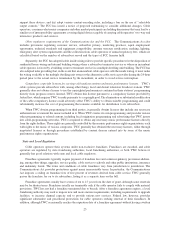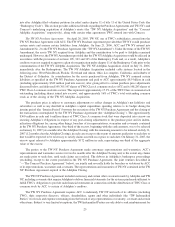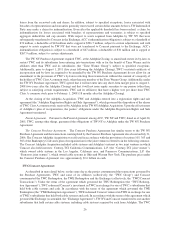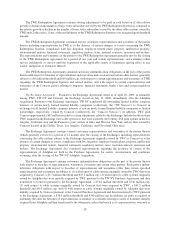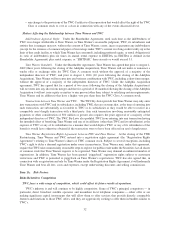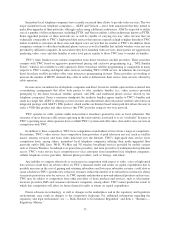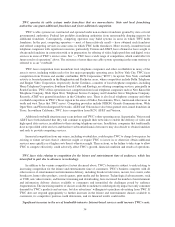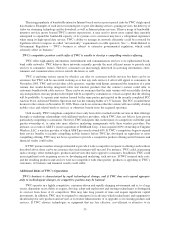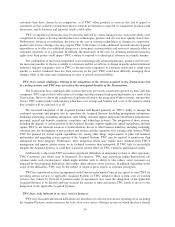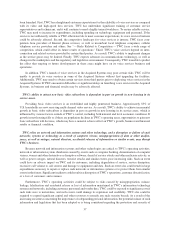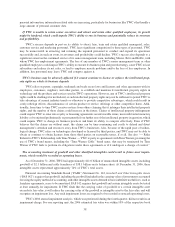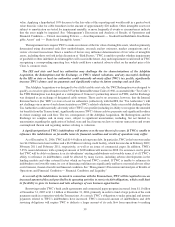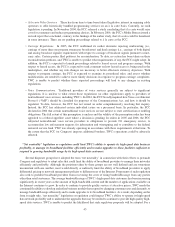Time Warner Cable 2006 Annual Report Download - page 38
Download and view the complete annual report
Please find page 38 of the 2006 Time Warner Cable annual report below. You can navigate through the pages in the report by either clicking on the pages listed below, or by using the keyword search tool below to find specific information within the annual report.Incumbent local telephone companies have recently increased their efforts to provide video services. The two
major incumbent local telephone companies — AT&T and Verizon — have both announced that they intend to
make fiber upgrades of their networks, although each is using a different architecture. AT&T is expected to utilize
one of a number of fiber architectures, including FTTN, and Verizon utilizes a fiber architecture known as FTTH.
Some upgraded portions of these networks are or will be capable of carrying two-way video services that are
technically comparable to TWC’s, high-speed data services that operate at speeds as high or higher than those TWC
makes available to customers in these areas and digital voice services that are similar to TWC’s. In addition, these
companies continue to offer their traditional phone services as well as bundles that include wireless voice services
provided by affiliated companies. In areas where they have launched video services, these parties are aggressively
marketing video, voice and data bundles at entry level prices similar to those TWC uses to market its bundles.
TWC’s video business faces intense competition from direct broadcast satellite providers. These providers
compete with TWC based on aggressive promotional pricing and exclusive programming (e.g., “NFL Sunday
Ticket,” which is not available to cable operators). Direct broadcast satellite programming is comparable in many
respects to TWC’s analog and digital video services, including TWC’s DVR service. In addition, the two largest
direct broadcast satellite providers offer some interactive programming features. These providers are working to
increase the number of HDTV channels they offer in order to differentiate their service from services offered by
cable operators.
In some areas, incumbent local telephone companies and direct broadcast satellite operators have entered into
co-marketing arrangements that allow both parties to offer synthetic bundles (i.e., video services provided
principally by the direct broadcast satellite operator, and DSL and traditional phone service offered by the
telephone companies). From a consumer standpoint, the synthetic bundles appear similar to TWC’s bundles and
result in a single bill. AT&T is offering a service in some areas that utilizes direct broadcast satellite video but in an
integrated package with AT&T’s DSL product, which enables an Internet-based return path that allows the user to
order a VOD-like product and other services that TWC provides using its two-way network.
TWC operates its cable systems under non-exclusive franchises granted by state or local authorities. The
existence of more than one cable system operating in the same territory is referred to as an “overbuild.” In some of
TWC’s operating areas, other operators have overbuilt TWC’s systems and offer video, data and/or voice services in
competition with TWC.
In addition to these competitors, TWC faces competition on individual services from a range of competitors.
For instance, TWC’s video service faces competition from providers of paid television services (such as satellite
master antenna services) and from video delivered over the Internet. TWC’s high-speed data service faces
competition from, among others, incumbent local telephone companies utilizing their newly-upgraded fiber
networks and/or DSL lines, Wi-Fi, Wi-Max and 3G wireless broadband services provided by mobile carriers
such as Verizon Wireless, broadband over power line providers, and from providers of traditional dial-up Internet
access. TWC’s voice service faces competition for voice customers from incumbent local telephone companies,
cellular telephone service providers, Internet phone providers, such as Vonage, and others.
Any inability to compete effectively or an increase in competition with respect to video, voice or high-speed
data services could have an adverse effect on TWC’s financial results and return on capital expenditures due to
possible increases in the cost of gaining and retaining subscribers and lower per subscriber revenue, could slow or
cause a decline in TWC’s growth rates, reduce its revenues, reduce the number of its subscribers or reduce its ability
to increase penetration rates for services. As TWC expands and introduces new and enhanced products and services,
TWC may be subject to competition from other providers of those products and services, such as telecommu-
nications providers, ISPs and consumer electronics companies, among others. TWC cannot predict the extent to
which this competition will affect its future financial results or return on capital expenditures.
Future advances in technology, as well as changes in the marketplace and in the regulatory and legislative
environments, may result in changes to the competitive landscape. For additional information regarding the
regulatory and legal environment, see “— Risks Related to Government Regulation” and Item 1, “Business —
Regulatory Matters.”
33


